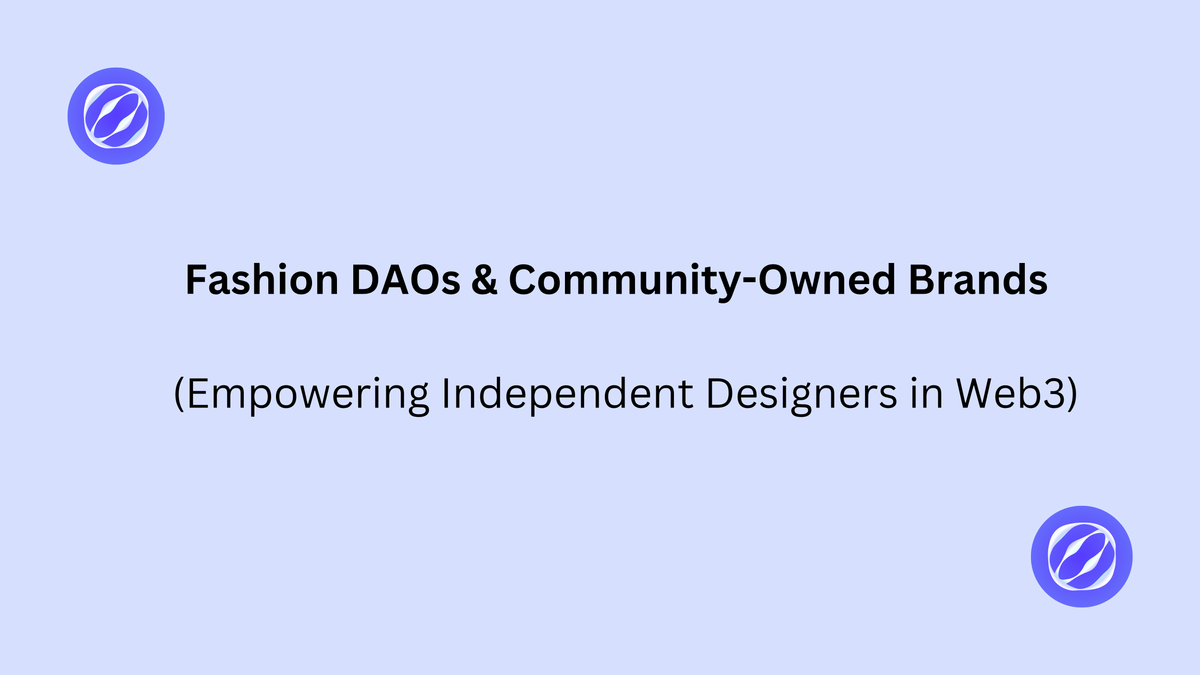Fashion DAOs & Community-Owned Brands (Empowering Independent Designers in Web3)

Fashion DAO, a place where dreams take flight, Through style with blockchain’s might. Designers thrive, their voices strong, A world where all designers belong. Decentralized, bold, and free, Shaping trends in Web3. Innovation leads the way, Fashion’s future starts today.
Introduction: Who decides what’s in style? Who holds the power in fashion? Why do so many talented designers struggle to break through while big brands dominate? For decades, the fashion industry has been controlled by corporations, limiting opportunities for independent designers. The traditional model relies on exclusivity, centralized decision-making, and barriers that make it difficult for emerging talents to thrive. But with Web3 technology, a new era is unfolding , one where creativity is decentralized, and ownership is shared. Fashion DAOs (Decentralized Autonomous Organizations) and Community-Owned Brands are revolutionizing the industry, giving designers direct access to funding, collaboration, and governance. This shift empowers creatives to shape the future of fashion on their own terms, without the constraints of traditional gatekeepers. Let’s explore what fashion DAOs are and how they are transforming the industry. Fashion DAOs & Community-Owned Brands. ( Empowering Independent Designers in Web3 ) The fashion industry has long been dominated by major brands, corporations, and centralized decision-making processes. However, the rise of Web3 technology is reshaping the landscape, enabling more collaborative, community-driven models. One of the most transformative innovations in this space is the concept of Fashion DAOs (Decentralized Autonomous Organizations) and Community-Owned Brands. These decentralized structures allow independent designers to gain direct access to funding, collaboration, and ownership without the constraints of traditional industry gatekeepers. What Are Fashion DAOs? A DAO (Decentralized Autonomous Organization) is a blockchain-based entity governed by smart contracts and decentralized decision-making. Instead of a single owner or executive board making decisions, DAOs operate through token-based voting mechanisms where community members have a say in the brand’s future. In the fashion industry, DAOs serve as
- Crowdsourced funding platforms for designers to launch collections.
- Decentralized creative hubs where members vote on design choices, collaborations, and partnerships.
- Supply chain transparency tools that ensure ethical sourcing and sustainability.
- Revenue-sharing models that reward community members for their participation. Fashion DAOs leverage blockchain, smart contracts, and token economies to create a system where designers and fashion enthusiasts can actively participate in shaping a brand’s direction. Briefly, let's explore how community-owned brands has a shift in fashion business models. Traditionally, fashion brands are controlled by a small group of executives or investors. Community-owned brands, powered by Web3, break this structure by distributing ownership among designers, customers, and stakeholders through NFTs, tokens, or governance mechanisms. How Community-Owned Brands Work: 1. Tokenized Membership & Ownership:
- Supporters can purchase governance tokens or NFTs that grant them voting rights and access to exclusive brand experiences. Example: Holding a digital fashion NFT might allow a person to vote on design choices or receive limited-edition physical versions. 2. Crowdfunding & Direct-to-Community Funding:
- Designers no longer need to rely on venture capital or fashion houses for funding. Instead, they can launch collections through NFT sales or DAO treasury proposals. Example: A designer can propose a collection, and the DAO community votes to fund it via treasury allocations. 3. Revenue Distribution & Incentives:
- Instead of profits going solely to corporate owners, a DAO can implement revenue-sharing models where token holders, designers, and contributors earn rewards. 4. Decentralized Design & Creative Collaboration:
- Brands can hold open design competitions allowing DAO members to submit and vote on designs.
- This encourages inclusivity, allowing unknown but talented designers to get recognition. How DAOs Empower Independent Designers in Web3 Web3 and DAOs eliminate the barriers of entry that have traditionally kept independent designers from thriving. Here’s how: 1. Through Democratizing Access to Resources.
- In traditional fashion, launching a brand requires significant capital for production, marketing, and retail distribution.
- DAOs remove intermediaries, allowing designers to crowdfunds collections through NFT sales, governance token support, or grants from the DAO treasury. Example: Digitalax, one of the first Web3 fashion DAOs, supports indie designers by providing decentralized funding and a platform to sell digital and physical fashion. 2. Enabling Direct Engagement With Consumers & Collectors
- Designers don’t have to rely on department stores or online retailers to distribute their products. Instead, they can build a direct-to-community (DTC) model where token holders act as brand ambassadors and customers.
- Fashion DAOs create a loyal customer base by offering governance privileges, early access, or exclusive NFTs to their community. 3. Royalties & Fair Compensation
- Designers often lose control over their work once a collection is sold.
- With blockchain and smart contracts, designers can program royalties into their NFTs or digital garments, ensuring they receive a percentage of secondary sales forever.
Example: The UNXD fashion DAO a digital luxury fashion platform, ensures creators earn from resale transactions. 4. Decentralized Design Innovation
DAOs allow designers from different parts of the world to collaborate seamlessly creating experimental collections that blend physical and digital fashion. Members can submit designs, and the community votes on which ones get produced. Example: DRESSX DAO enables digital fashion creators to propose designs that the community votes to mint as NFTs.
5. Sustainability & Ethical Production
DAOs can set strict governance rules regarding sustainability, ensuring that brands adhere to ethical sourcing and environmentally friendly practices. Example: The RSTLSS platform founded by Web3-native fashion creators, uses blockchain to track materials and carbon footprints, ensuring transparent, sustainable production. Successful Fashion DAOs & Community-Owned Brands Here are a list of some pioneering Fashion DAOs making an impact: 1. Digitalax - One of the first fashion DAOs supporting Web3-native designers. - Focuses on digital fashion, NFT wearables, and blockchain-based supply chains. Checkout Digitalax Collection 2. The Fabricant DAO - A leading digital fashion house creating high-end virtual clothing. - Uses blockchain to ensure full designer ownership of digital garments. Visit Website
3. SYKY Collective A Web3 fashion platform empowering up-and-coming designers through blockchain-based funding and distribution. Visit Website
4. DRESSX Focuses on AR wearables, NFTs, and digital fashion, allowing users to own and wear blockchain-verified digital clothing. 5. Red DAO - A luxury digital fashion DAO that collects, invests, and supports fashion NFTs and metaverse wearables. Visit Website .
As blockchain technology continues to evolve, Fashion DAOs and community-owned brands will redefine the industry’s power dynamics. The shift toward decentralization, direct-to-community engagement, and sustainable practices gives independent designers the freedom to innovate without restrictions. The rise of Fashion DAOs marks a paradigm shift in how fashion is created, owned, and distributed. Independent designers now have the tools, platforms, and funding mechanisms to thrive in a decentralized fashion industry. The question is no longer if Web3 will change fashion but how quickly designers and consumers will embrace this new era of decentralised creativity. Would you like insights on how to start or join a fashion DAO? Please share your thoughts in the comments below, and don’t forget to subscribe to my pool for more insights on the intersection of fashion and technology! See you shortly…


Comments ()